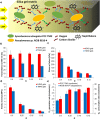Silica ecosystem for synergistic biotransformation
- PMID: 27264916
- PMCID: PMC4893658
- DOI: 10.1038/srep27404
Silica ecosystem for synergistic biotransformation
Abstract
Synergistical bacterial species can perform more varied and complex transformations of chemical substances than either species alone, but this is rarely used commercially because of technical difficulties in maintaining mixed cultures. Typical problems with mixed cultures on scale are unrestrained growth of one bacterium, which leads to suboptimal population ratios, and lack of control over bacterial spatial distribution, which leads to inefficient substrate transport. To address these issues, we designed and produced a synthetic ecosystem by co-encapsulation in a silica gel matrix, which enabled precise control of the microbial populations and their microenvironment. As a case study, two greatly different microorganisms: Pseudomonas sp. NCIB 9816 and Synechococcus elongatus PCC 7942 were encapsulated. NCIB 9816 can aerobically biotransform over 100 aromatic hydrocarbons, a feat useful for synthesis of higher value commodity chemicals or environmental remediation. In our system, NCIB 9816 was used for biotransformation of naphthalene (a model substrate) into CO2 and the cyanobacterium PCC 7942 was used to provide the necessary oxygen for the biotransformation reactions via photosynthesis. A mathematical model was constructed to determine the critical cell density parameter to maximize oxygen production, and was then used to maximize the biotransformation rate of the system.
Figures



 curve indicates the optimal operation conditions where the system has neither an oxygen deficit or surplus. The maximum biotransformation rate is achieved at ρC = ρcr and corresponding ρN on the
curve indicates the optimal operation conditions where the system has neither an oxygen deficit or surplus. The maximum biotransformation rate is achieved at ρC = ρcr and corresponding ρN on the  curve c) Schematic of the experiment setup used for biotransformation of naphthalene. Four cases were tested: I) No cells (Negative control), II) NCIB 9816 (Oxygen is limited to the dissolved oxygen in solution), III) NCIB 9816 with headspace (Supplemental oxygen is provided via the air in the headspace), IV) NCIB 9816 with PCC 7942 (Oxygen is provided by the co-encapsulated PCC 7942) (d) Results of the naphthalene biotransformation experiment. NCIB 9816 with co-encapsulated PCC 7942 achieved the highest biotransformation ratio (All error bars indicate standard deviation, n = 3).
curve c) Schematic of the experiment setup used for biotransformation of naphthalene. Four cases were tested: I) No cells (Negative control), II) NCIB 9816 (Oxygen is limited to the dissolved oxygen in solution), III) NCIB 9816 with headspace (Supplemental oxygen is provided via the air in the headspace), IV) NCIB 9816 with PCC 7942 (Oxygen is provided by the co-encapsulated PCC 7942) (d) Results of the naphthalene biotransformation experiment. NCIB 9816 with co-encapsulated PCC 7942 achieved the highest biotransformation ratio (All error bars indicate standard deviation, n = 3).Similar articles
-
Engineering of a silica encapsulation platform for hydrocarbon degradation using Pseudomonas sp. NCIB 9816-4.Biotechnol Bioeng. 2016 Mar;113(3):513-21. doi: 10.1002/bit.25821. Epub 2015 Sep 22. Biotechnol Bioeng. 2016. PMID: 26332745
-
Use of silica-encapsulated Pseudomonas sp. strain NCIB 9816-4 in biodegradation of novel hydrocarbon ring structures found in hydraulic fracturing waters.Appl Environ Microbiol. 2014 Aug;80(16):4968-76. doi: 10.1128/AEM.01100-14. Epub 2014 Jun 6. Appl Environ Microbiol. 2014. PMID: 24907321 Free PMC article.
-
Biotransformation of 2,4-dinitrotoluene in a phototrophic co-culture of engineered Synechococcus elongatus and Pseudomonas putida.Microb Biotechnol. 2020 Jul;13(4):997-1011. doi: 10.1111/1751-7915.13544. Epub 2020 Feb 16. Microb Biotechnol. 2020. PMID: 32064751 Free PMC article.
-
Adsorption and Biodegradation of Aromatic Chemicals by Bacteria Encapsulated in a Hydrophobic Silica Gel.ACS Appl Mater Interfaces. 2017 Aug 16;9(32):26848-26858. doi: 10.1021/acsami.7b06791. Epub 2017 Jul 31. ACS Appl Mater Interfaces. 2017. PMID: 28719174
-
Upflow anaerobic sludge blanket reactor--a review.Indian J Environ Health. 2001 Apr;43(2):1-82. Indian J Environ Health. 2001. PMID: 12397675 Review.
Cited by
-
Method to Isolate Dormant Cancer Cells from Heterogeneous Populations.Methods Mol Biol. 2022;2394:19-29. doi: 10.1007/978-1-0716-1811-0_2. Methods Mol Biol. 2022. PMID: 35094319
References
-
- Biebl H., Menzel K., Zeng A. P. & Deckwer W. D. Microbial production of 1,3-propanediol. Applied Microbiology and Biotechnology 52, 289–297 (1999). - PubMed
Publication types
MeSH terms
Substances
LinkOut - more resources
Full Text Sources
Other Literature Sources
Research Materials

